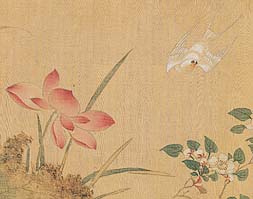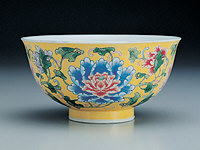|
|
 |
 |
 The
National Palace Museum in Taipei is home to a collection of
over 700,000 items. Assembling a collection of this size spanning
seven millennia of Chinese history and pre-history was a mammoth
task requiring the joint efforts of countless collectors over
the centuries. The
National Palace Museum in Taipei is home to a collection of
over 700,000 items. Assembling a collection of this size spanning
seven millennia of Chinese history and pre-history was a mammoth
task requiring the joint efforts of countless collectors over
the centuries.
Chinese emperors began avidly collecting works by famous artists
as early as the Tang period (A.D. 618-906). One notable example
was
Emperor Taizong of the Tang dynasty (r. 627-649), who resorted
to trickery to obtain the original "Preface to the Lanting Collection"
by calligrapher Wang Xizhi. Emperor Huizong (r. 1101-1125, Song
dynasty), himself a keen artist, commissioned scholars to catalog
the imperial collection of his own day and write biographies
of the Chinese painters and calligraphers whose works were included
there. The Qianlong Emperor (r. 1736-1795, Qing dynasty), another
great lover of art and antiquities, turned his personal study
(the Sanxitang or "Hall of Three Rarities") into a repository
for three celebrated ancient calligraphic works.
|
|
 Chinese
emperors were not only keen collectors of art, many were also
accomplished artists in their own right. Calligraphy by Emperor
Xuanzong (r. 712-755, Tang dynasty), and flower & bird paintings
by Emperor Huizong (Song dynasty), are both highly renowned.
Emperors were also major sponsors of art. Chinese court artists
held official rank and received stipends that enabled them to
pursue creative work without distraction. Imperial taste was
often a moving factor in determining artistic trends of the
period. Examples include the brilliant achievement of Southern
Song Guan ware under the aegis of Emperor
Gaozong
(r. 1127-1162), the development of
Ming porcelain Chinese
emperors were not only keen collectors of art, many were also
accomplished artists in their own right. Calligraphy by Emperor
Xuanzong (r. 712-755, Tang dynasty), and flower & bird paintings
by Emperor Huizong (Song dynasty), are both highly renowned.
Emperors were also major sponsors of art. Chinese court artists
held official rank and received stipends that enabled them to
pursue creative work without distraction. Imperial taste was
often a moving factor in determining artistic trends of the
period. Examples include the brilliant achievement of Southern
Song Guan ware under the aegis of Emperor
Gaozong
(r. 1127-1162), the development of
Ming porcelain  from
Jingdezhen under the strict regime of the Xuande Emperor (r.
1426-1435), and in the Qing period the introduction of Western
enamel techniques by the Kangxi Emperor (r. 1662-1722), and
the vogue for imitating antiquity inspired by the Qianlong Emperor. from
Jingdezhen under the strict regime of the Xuande Emperor (r.
1426-1435), and in the Qing period the introduction of Western
enamel techniques by the Kangxi Emperor (r. 1662-1722), and
the vogue for imitating antiquity inspired by the Qianlong Emperor.
It is hard to find parallels to the Chinese emperors' passion
for art elsewhere in the world. It is their success in preserving
ancient artifacts and works of art that has led to the National
Palace Museum having the impressive collection we see today.
We are indeed fortunate that the traces of 5,000 years of Chinese
civilization can be reconstructed through this priceless collection
of cultural artifacts. |
|
|


 The
National Palace Museum in Taipei is home to a collection of
over 700,000 items. Assembling a collection of this size spanning
seven millennia of Chinese history and pre-history was a mammoth
task requiring the joint efforts of countless collectors over
the centuries.
The
National Palace Museum in Taipei is home to a collection of
over 700,000 items. Assembling a collection of this size spanning
seven millennia of Chinese history and pre-history was a mammoth
task requiring the joint efforts of countless collectors over
the centuries. Chinese
emperors were not only keen collectors of art, many were also
accomplished artists in their own right. Calligraphy by Emperor
Xuanzong (r. 712-755, Tang dynasty), and flower & bird paintings
by Emperor Huizong (Song dynasty), are both highly renowned.
Emperors were also major sponsors of art. Chinese court artists
held official rank and received stipends that enabled them to
pursue creative work without distraction. Imperial taste was
often a moving factor in determining artistic trends of the
period. Examples include the brilliant achievement of Southern
Song Guan ware under the aegis of Emperor
Gaozong
(r. 1127-1162), the development of
Ming porcelain
Chinese
emperors were not only keen collectors of art, many were also
accomplished artists in their own right. Calligraphy by Emperor
Xuanzong (r. 712-755, Tang dynasty), and flower & bird paintings
by Emperor Huizong (Song dynasty), are both highly renowned.
Emperors were also major sponsors of art. Chinese court artists
held official rank and received stipends that enabled them to
pursue creative work without distraction. Imperial taste was
often a moving factor in determining artistic trends of the
period. Examples include the brilliant achievement of Southern
Song Guan ware under the aegis of Emperor
Gaozong
(r. 1127-1162), the development of
Ming porcelain  from
Jingdezhen under the strict regime of the Xuande Emperor (r.
1426-1435), and in the Qing period the introduction of Western
enamel techniques by the Kangxi Emperor (r. 1662-1722), and
the vogue for imitating antiquity inspired by the Qianlong Emperor.
from
Jingdezhen under the strict regime of the Xuande Emperor (r.
1426-1435), and in the Qing period the introduction of Western
enamel techniques by the Kangxi Emperor (r. 1662-1722), and
the vogue for imitating antiquity inspired by the Qianlong Emperor.